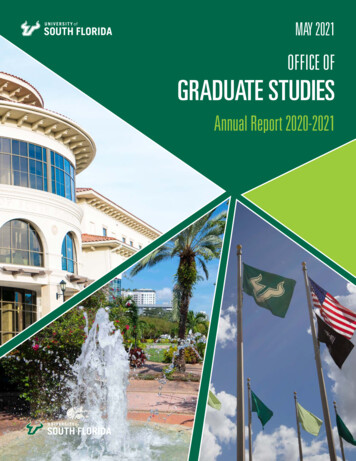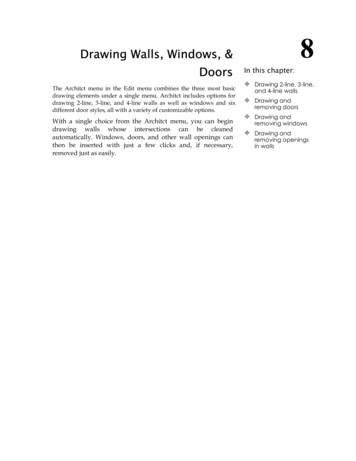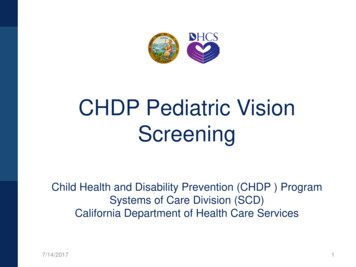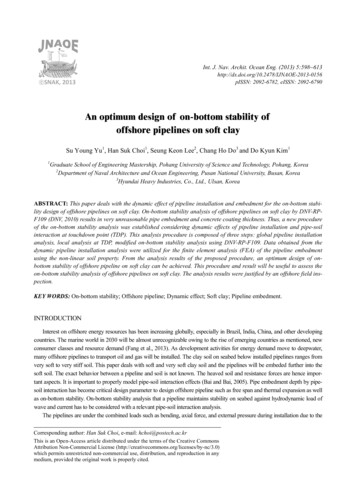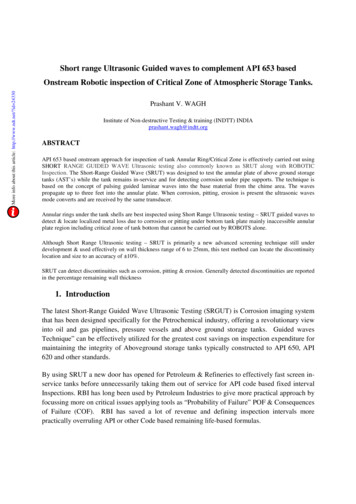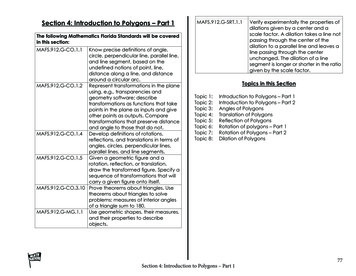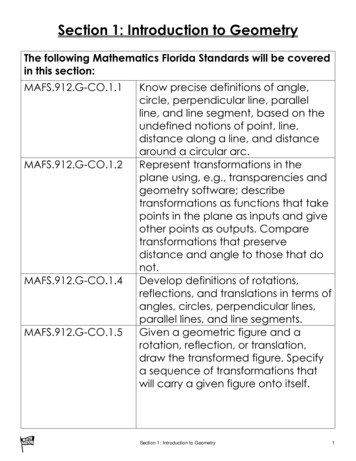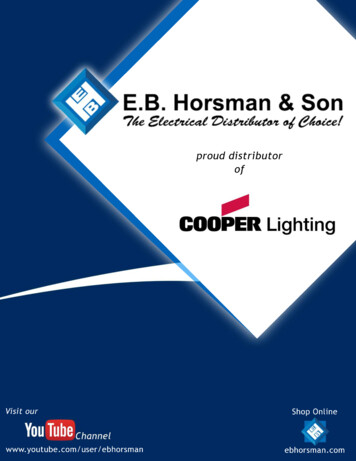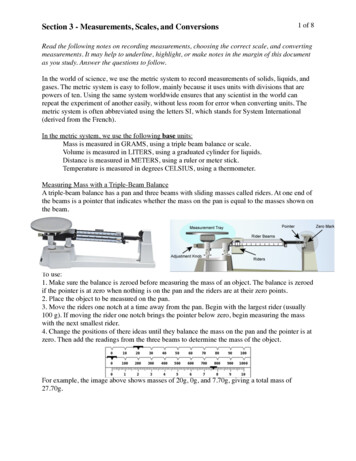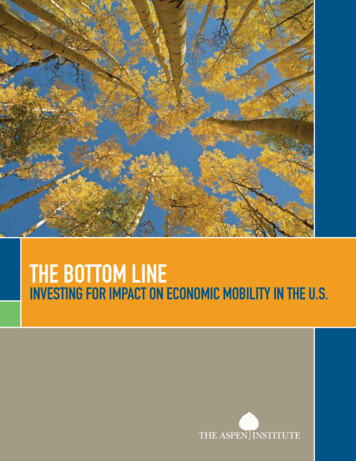
Transcription
THE BOTTOM LINEINVESTING FOR IMPACT ON ECONOMIC MOBILITY IN THE U.S.THE BOTTOM LINE: INVESTING FOR IMPACT ON ECONOMIC MOBILITY IN THE U.S.1
This project was made possible with the generous support of theW.K. Kellogg Foundation.ASCEND AT THE ASPEN INSTITUTEAscend at the Aspen Institute is the national hub for breakthrough ideas and collaborations that movechildren and their parents toward educational success and economic security. Ascend takes a twogeneration approach to its work — focusing on children and their parents together — and it brings agender and racial equity lens to its analysis. Ascend believes that early childhood and postsecondaryeducation, economic assets, social capital, and health and well-being are the core elements that createan intergenerational cycle of opportunity. As a new model of social innovation, Ascend at the AspenInstitute is engaged in three strategies: Elevating and investing in two-generation programs, policies, and community solutions; Building a network of diverse leaders through a national fellowship program and a learning network;and Engaging the perspectives, strengths, and resilience of low-income families to inform programs ascendPROGRAM ON PHILANTHROPY AND SOCIAL INNOVATION AND THE IMPACT ECONOMY INITIATIVEThe Aspen Institute’s Program on Philanthropy and Social Innovation (PSI) seeks to inform and maximizethe impact of philanthropists, social investors, and the organizations they support. The program’s theoryof change rests on the premise that if leaders have clarity about their values, are collaborative in theirapproach to problem-solving, and are aware of the strategies and potential partnerships available tothem, they are more likely to succeed in advancing the social good.PSI’s Impact Economy Initiative, which was launched in 2010, seeks to build and assess models forinvestments and enterprises that generate both financial profit and positive social or environmentalreturns. Learn more at www.aspeninstitute.org/psiPARTNER: GEORGETOWN UNIVERSITY MCDONOUGH SCHOOL OF BUSINESSGLOBAL SOCIAL ENTERPRISE INITIATIVEThe Global Social Enterprise Initiative at Georgetown’s McDonough School of Businessaims to prepare current and future leaders to make responsible management decisionsthat yield both economic and social value. Through practical training for global businessleaders, the initiative promotes transformative solutions to and impactful investmentsin the world’s significant challenges in health and well-being, economic growth, the environment andinternational development.Learn more at stitute.org
FOREWORDThere is no greater challenge in the United States today than income inequality. It has been 50 years sincethe War on Poverty began. We have made progress but not enough. More than 32 million children live inlow-income families, and racial and gender gaps persist. For the first time, Americans do not believe lifewill be better for the next generation. We have both a moral and an economic imperative to fuel socialand economic mobility in this country.The Aspen Institute was founded in 1950 as a place to address the critical issues of our time. Today,ensuring that the American dream can be a possibility for all and be passed from one generation tothe next is that issue. This commitment is at the heart of the work of many policy programs at the AspenInstitute. Ending the cycle of poverty requires leadership and hard work across all sectors, from nonprofitorganizations, philanthropies, and academia to the government and private sector.The Bottom Line: Investing for Impact on Economic Mobility in the U.S. recognizes the importance oflearning from all sectors in tackling any challenge. Specifically, it builds on opportunities in the growingimpact investment field. The report draws on the lessons from market-based approaches to identify toolsand strategies that can help move the needle on family economic security. In this report, you will find thefollowing: Case studies – An opportunity to go under the hood on deals with the Bank of America, W.K. KelloggFoundation, Acelero Learning, and others; Point of view essays – Insights and lessons from leaders in the field; Deals at a glance – Snapshots of impact investors and what they have learned, including the KresgeFoundation, Living Cities, and the MacArthur Foundation; and Survey results and lessons learned – Trends among active and emerging players in the U.S. impactinvestment field and the lessons that can be applied to economic mobility in the U.S.We are pleased to offer this expanded perspective on impact investing in the U.S. and the lessons forinvestors, philanthropists, and non-profits working to build strong and prosperous families and communities.Sincerely,Walter IsaacsonCEO, the Aspen InstituteElliot GersonExecutive Vice President, the Aspen InstituteAnne MosleVice President, the Aspen InstituteJane WalesVice President, the Aspen InstituteThe Bottom Line: Investing for Impact on Economic Mobility in the U.S.3
CONTENTSForeword by Walter Isaacson, Elliot Gerson, Anne Mosle, and Jane Wales3Acknowledgements6Executive Summary9Introduction11Aspen Institute - Georgetown University McDonough School of BusinessImpact Investing Survey15Beyond the Survey: Trends in the Field18Essay: All In: Reinventing What a Foundation Can Be in the 21st Centuryby Clara Miller, F.B. Heron Foundation22Essay: The McKnight Foundation’s Secret Sauceby Kate Wolford, The McKnight Foundation26Essay: Aligning Disciplined Traditional Investing Principles With CatalyticSocial Change by Audrey Choi, Morgan Stanley Institute for Sustainable Investing30Education: An in-depth look Early Childhood Education K-12 Education Literacy35353637Case study: Acelero Learning: For-Profit Head Start Program Pays Offfor Children, but Investors Must Wait40Essay: First Book: Creating Disruptive Innovation with Cross-Sector Collaborationsby Kyle Zimmer and Jane Robinson, First Book44Essay: Investing to Scale Early-Stage Social Enterprisesby Jim Bildner, Draper Richards Kaplan Foundation49Essay: Talent for Impact: Lessons Learned from Impact Investingby Monisha Kapila, ProInspire52Early Childhood Education and Pay for Success: From Theory to PracticeIn partnership with the Institute for Child Success56Economic Assets: An in-depth look Recidivism Affordable Housing Place-Based Investing Microenterprise61616263654www.aspeninstitute.org
Case study: Rebuilding Lives, Reducing Costs: A New Financial Model forEmployment versus Incarceration68Deals at a Glance: Calvert Foundation74Deals at a Glance: The John D. and Catherine T. MacArthur Foundation77Deals at a Glance: Living Cities81Essay: Want Impact? Build Market-Relevant Microlenders by Joyce Klein, the AspenInstitute Microenterprise Fund for Innovation, Effectiveness, Learning and Dissemination84Essay: Closing the Microbusiness Gap with Targeted Investments in Social Capitalby Peter Roberts, Emory University, Social Enterprise @ Goizueta,and Ross Baird, Village Capital89Essay: Trends in Seed-Stage Social Entrepreneurship: The Importance ofInvesting in Emerging Social Entrepreneurs to Build Family Economic Securityby Cheryl Dorsey and Min Pease, Echoing Green94Health and Well-Being: An in-depth look99Case study: CarePayment: Financing Out-of-Pocket Medical DebtWhile Keeping Bill Collectors at Bay102Deals at a Glance: The Kresge Foundation107Essay: Bridging That Critical Space Between Heart and Headby Ron Cordes, Cordes Foundation111Essay: Insights from Abroad: Impact Investing in Emerging Markets byRandall Kempner and Alexander Pan, Aspen Network of Development Entrepreneurs 115Essay: Making Sure the Juice is Worth the Squeeze by John Goldstein, Imprint Capital119The Role of U.S. Policy in Impact Investing123Conclusion126Endnotes129Appendix A: List of investors responding to survey131Appendix B: Definitions of key terms132Appendix C: Investor and sample investment profiles from survey138The Bottom Line: Investing for Impact on Economic Mobility in the U.S.5
ACKNOWLEDGEMENTSWe extend our appreciation to our essay, deal, and case study contributors:Hanna Azemati, New York StateTracy Barba, Social FinanceRoss Baird, Village CapitalTony Berkley, W.K. Kellogg FoundationPaul Bernstein, Pershing Square FoundationJim Bildner, Draper Richards Kaplan FoundationDash Boyer-Olson, Bank of America Merrill LynchMatt Burkhard, Morgan Stanley Institute for Sustainable InvestingAudrey Choi, Morgan Stanley Institute for Sustainable InvestingJustin Conway, Calvert FoundationRon Cordes, Cordes FoundationKimberlee Cornett, The Kresge FoundationCheryl Dorsey, Echoing GreenJohn Duong, W.K. Kellogg FoundationLois Erwin, Southern BancorpDavid Fukuzawa, The Kresge FoundationCraig Froude, Aequitas CapitalChris Gabrieli, Ironwood Capital ManagementAnn Garnier, CarePaymentBrian Goebel, Social Enterprise @ Goizueta, Emory University Goizueta Business SchoolJohn Goldstein, Imprint CapitalBen Hecht, Living CitiesNancy Haung, Draper Richards Kaplan FoundationRobert Jesenik, Aequitas CapitalMargot Kane, Calvert FoundationMonisha Kapila, ProInspireBenjamin Kaufman, Southern BancorpRandall Kemper, Aspen Network of Development EntrepreneursJoyce Klein, Aspen Institute MicroenterpriseSurya Kolluri, Bank of America Merrill LynchNajada Kumbuli, Calvert FoundationAaron Lieberman, Acelero LearningAndy MacRitchie, Aequitas CapitalHuntley McNabb, CarePaymentMarta Nelson, Center for Employment OpportunitiesClara Miller, F.B. Heron FoundationNicole Miller, CarePaymentDominik Mjartan, Southern BancorpKinchen O’Keefe, Southern Bancorp6www.aspeninstitute.org
Brian Oliver, Aequitas CapitalTracy Palandjian, Social FinanceAlexander Pan, Aspen Network of Development EntrepreneursMin Pease, Echoing GreenPeter Roberts, Social Enterprise @ Goizueta, Emory University Goizueta Business SchoolJane Robinson, FirstBookSam Schaeffer, Center for Employment OpportunitiesJeff Schoenberg, Pritzker FoundationDebra Schwartz, The John D. and Catherine T. MacArthur FoundationRory Sipp, Acelero LearningJackie VanderBrug, U.S. TrustBrenda Van Gorder, Granite SchoolsDarrin Williams, Southern BancorpHenry Wilde, Acelero LearningKate Wolford, The McKnight FoundationKyle Zimmer, FirstBookSurvey contributorsWe are grateful to the institutions who who took the time to participate in our survey. They are listed onpage 21, where we outline the survey results, and in the appendix.Co-convenorsDeborah Smolover and America ForwardJoe Waters and the Institute for Child SuccessPeer reviewersWe appreciate the expertise and time of the peer reviewers who gave extremely helpful input to the earlylandscaping drafts of this report: Ashley Allen, i2 Capital Group; Robert Foster, Aspen Institute;Gayle Peterson, Partners for Change; Aaron Ratner, i2 Capital Group; Andrew Schlack, CalvertFoundation; and Sonal Shah, Case Foundation.Project leadershipAnne Mosle, vice president, the Aspen Institute, and Jane Wales, vice president, the Aspen InstituteProject teamAscend at the Aspen Institute staff: Sandhya Deshetty, Marissa Mahoney, and Lori Severens; and Programon Philanthropy and Social Innovation Staff: Tracey Rutnik and Zach WennerPartnerMelissa Bradley, professor, Georgetown University McDonough School of Business Global Social EnterpriseInitiative. Our appreciation also to Michael McLaughlin, Stephanie Miller, and Michael Skvasik for their workon the survey design and analysis.ConsultantsSpecial thanks to our writing and research consultants: David Bank, Jennifer Griffin, David Martin, andJessica Pothering; and Gayle Bennett for copyediting.This project was made possible with the generous support of the W.K. Kellogg Foundation. We would alsolike to thank the Omidyar Network and the Rockefeller Foundation for their support of the Program onPhilanthropy and Social lnnovation’s Impact Economy Initiative.The Bottom Line: Investing for Impact on Economic Mobility in the U.S.7
WHAT YOU WILL FIND IN THIS REPORT: Aspen Institute and Georgetown UniversitySurvey – Findings and analysis of a surveyof active and emerging impact investors; Case studies – An opportunity to gounder the hood on deals with the Bankof America, W.K. Kellogg Foundation,Acelero Learning, and others; Point of view essays – Insights and lessonsfrom leaders in the field; Deals at a glance – Snapshots of impactinvestors and what they have learned; In-depth chapters on investments ineducation, economic assets, and healthand well-being – Investment areas withthe potential to advance economic andsocial mobility for low-income families.In each of these chapters you will findkey facts, investment examples, lessonslearned, and recommendations; and Appendices – Investor and sampleinvestment profiles from the Aspen Institutesurvey and a glossary of key terms.8www.aspeninstitute.org
EXECUTIVE SUMMARYAs a country, we have long believed inthe “American Dream” – through hardwork and opportunity, we can reach ourgoals. But with millions struggling, thosedreams are being eroded. Social andeconomic mobility has stagnated, andinequality is rising. Not only are familiesat risk but so is our nation’s economicsecurity.Interest in the field of impact investinghas skyrocketed. Potential market size,amount of available capital, and theopportunity for financial and socialimpact, particularly for our country’smost pressing problems, are allfactors in that growth. This report andaccompanying survey were designedto explore the landscape and lessonslearned of this growing field in the UnitedStates, with a focus on deal flow andreturns. We paid special attention toinvestments in education, economicassets, and health and well-being,investment areas with the potential toadvance economic and social mobilityfor low-income families.Adding rich depth and perspectivethroughout the report are the following: Case studies – An opportunity togo under the hood on deals withthe Bank of America, W.K. KelloggFoundation, Acelero Learning, andothers; Point of view essays – Insights andlessons from leaders in the field; and Deals at a glance – Snapshots ofimpact investors and what they havelearned.Guiding research questions: What is the current level ofinvestment activity and interest in theU.S. related to education, economicsecurity, and health and well-being? What tools, strategies, and models canbe distilled from early investments thatcould lead to better results for childrenand families? How can strategies be effectivelyshared with on-the-groundinnovators, foundations, policymakers, and impact investors?Aspen Institute and GeorgetownUniversity Impact Investing SurveyIn partnership with the GeorgetownUniversity McDonough School of Business,the Aspen Institute conducted a surveyof investors to assess activity and interestin impact investing in the U.S., with anemphasis on investments in education,economic assets, and health and wellbeing. Thirty-nine individuals responded,representing 32 institutional investors fromacross investor types.Nearly 69 percent of respondents investin the study’s target impact areas ofeducation, economic assets, and healthand well-being. For these respondents, impactinvesting is not a new practice. Sixtyfour percent indicated they havebeen active impact investors formore than 10 years. Their work is overwhelmingly backedby an institutional commitment topoverty (86 percent). Furthermore,32 percent reported employinga gender lens in the investmentdecision process, while 27 percentreported having a racial equity lens.Among all respondents, the averageinvestment transaction size varied fromless than 100,000 to more than 10million. Of target impact area investors,the majority of respondents indicatedan average transaction size between 100,000 and 3 million.The Bottom Line: Investing for Impact on Economic Mobility in the U.S.9
The majority of investments are deliveredvia funds or intermediaries.An increasing number of foundations areactive impact investors. Private sectorplayers, such as Goldman Sachs, Bankof America, and Morgan Stanley, aredeveloping business units dedicated toimpact investing.As with venture capital, a majority ofimpact investors find deal flow frompeers and other investors.Forty-five percent of respondents establishformal financial and social benchmarks,and 80 percent of those said theirportfolios are meeting or exceeding theestablished financial metrics, and 90percent are meeting or exceeding thesocial metrics. This provides evidence thatgood deals exist.The Aspen Institute used the survey togauge how investors’ work supportedeconomic and social mobility. Wenoted the following trends in advancingmobility: A majority of respondents areinvesting in target areas that supportlow-income families and those mostin need. Significant dollars are supportingstrategies to build mobility. Investors are leveraging variedorganizational structures to facilitateimpact on parents, children, andfamilies. The pipeline for investments is basedon social capital (trusted networksand relationships). Good deals exist to advanceeconomic mobility for U.S. families.Looking at the field as a whole, thetop five trends among impact investorsinclude: Focus on ‘place’; Leveraging CDFIs to increaseefficiency; and Emerging interest in metrics.Focus on education, economic assets,and health and well-being:Outlined in the report are in-depthsections on education, economic assets,and health and well-being. Opportunitiesin those investment areas are highlightedbelow.Education: Investing beyond school infrastructureto educational outcomes; Focusing on quality and efficiency;and Leveraging intermediaries to deploylarge amounts of capital effectively.Economic assets: Using diverse forms of capital toinitiate and sustain economicopportunity; Collaborating to invest in localecosystems; and Leveraging data to scale what worksand eliminate barriers.Health: Reducing disparities in access andquality of care; Managing the costs of care; and Investing in health systems.Enabling policy environment:Federal, state, and local governmentsare increasingly finding alignmentwith the goals of impact investors,leveraging a variety of policy levers,such as tax credits, co-investments, andprocurement policies to drive improvedoutcomes for parents and children incommunities across the country. Increased market players – movingbeyond private foundations; Foundations moving fromexperimentation to institutionalization;10www.aspeninstitute.org
IN THIS SECTION: Setting the stage: a nationat risk, yet optimistic andresilientINTRODUCTIONWhen Tameka Henry began searchingfor preschool programs for her daughter,she was not familiar with Head Startor the achievement gap. Raised by asingle mother, she knew that hard workand a quality education would be keyto breaking the cycle of poverty forher family. Henry soon found AceleroLearning, a for-profit social enterprisethat is committed to closing theachievement gap for children andfamilies served by Head Start Programs.At Acelero Learning, she not onlylearned about the achievement gapbut also how she, as a parent, couldhelp close the gap for her children.Since leaving Acelero Learning, Henry’sdaughter has been a straight-A student.When she was in the fourth grade, shewas reading at a sixth grade level.Founded by Aaron Lieberman andHenry Wilde, Acelero Learning is a primeexample of how both financial andhuman resources from across sectors canbe leveraged to design and employ amarket-based approach to improvingoutcomes for low-income children andfamilies in the U.S. It serves 5,000 lowincome children directly, preparingthem to enter kindergarten, and another20,000 benefit from Acelero Learning’stools, training, and resources. Goals, guiding researchquestions, and contentoutlineshrinking budgets, publicagencies need ways tocut costs while meetingpublic needs. Private financial institutionsnote growing c
Craig Froude, Aequitas Capital Chris Gabrieli, Ironwood Capital Management Ann Garnier, CarePayment Brian Goebel, Social Enterprise @ Goizueta, Emory University Goizueta Business School John Goldstein, Imprint Capital Ben Hecht, Living Cities Nancy Haung, Draper Richards Kaplan Foundation Robert Jesenik,
